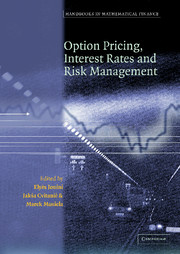Book contents
- Frontmatter
- Contents
- List of Contributors
- Introduction
- Part one Option Pricing: Theory and Practice
- Part two Interest Rate Modeling
- 7 A Geometric View of Interest Rate Theory
- 8 Towards a Central Interest Rate Model
- 9 Infinite Dimensional Diffusions, Kolmogorov Equations and Interest Rate Models
- 10 Modelling of Forward Libor and Swap Rates
- Part three Risk Management and Hedging
- Part four Utility Maximization
8 - Towards a Central Interest Rate Model
from Part two - Interest Rate Modeling
Published online by Cambridge University Press: 29 January 2010
- Frontmatter
- Contents
- List of Contributors
- Introduction
- Part one Option Pricing: Theory and Practice
- Part two Interest Rate Modeling
- 7 A Geometric View of Interest Rate Theory
- 8 Towards a Central Interest Rate Model
- 9 Infinite Dimensional Diffusions, Kolmogorov Equations and Interest Rate Models
- 10 Modelling of Forward Libor and Swap Rates
- Part three Risk Management and Hedging
- Part four Utility Maximization
Summary
Introduction
In recent years, the appearance of a new class of term structure of interest rate models has attracted the interest of practitioners. These so-called Market Models provide both an arbitrage-free pricing framework and pricing formulae that conform to the current (and accepted) market practice.
This class of model can effectively be split into two types: those that model forward Libor rates, and those that model forward swap rates. The Libor rate models, such as those introduced in Miltersen et al. (1997), Brace et al. (1997) and Musiela and Rutkowski (1997a,b), allow caps to be priced in a manner consistent with market practice, while the swap rate models, such as the one proposed by Jamshidian (1997), do the same for swaptions. However, these two approaches are fundamentally incompatible because Libor rates and swap rates cannot both be lognormal in an arbitrage-free framework.
The formulae currently in use in the market are based on extensions of the wellknown Black–Scholes option formula, and are, in fact, known as the Black cap and swaption formulae. In the case of swaptions, the swap rate replaces the stock price as being the market observable parameter assumed to follow lognormal dynamics. Other concepts that are related to (and easily calculated using) the Black–Scholes option formula can also be extended to the case of swaptions, such as the option sensitivities or Greeks. These give an indication as to the likely magnitude and direction of the change in option price under changes in the swap rate value and/or volatility.
- Type
- Chapter
- Information
- Handbooks in Mathematical FinanceOption Pricing, Interest Rates and Risk Management, pp. 278 - 313Publisher: Cambridge University PressPrint publication year: 2001
- 15
- Cited by



